Penggunaan Aplikasi Ollin by Nagari oleh Nasabah ASN Bank Nagari di Wilayah Sumatera Barat dengan Pendekatan Technology Acceptance Model (TAM)
DOI:
https://doi.org/10.38035/jafm.v6i4.2464Keywords:
Perceived Usefulness, Perceived Ease of Use, Attitude Towards Using, Behavioral Intention to Use, Actual UseAbstract
Penelitian ini bertujuan untuk menganalisis pengaruh perceived usefulness dan perceived ease of use terhadap behavioral intention to use serta dampaknya pada actual use aplikasi Ollin by Nagari dengan attitude towards using sebagai variabel intervening, studi Pada Nasabah ASN Bank Nagari Wilayah Sumatera Barat. Jenis penelitian yang digunakan dalam penelitian ini adalah explanatory research, dengan metode penelitiannya adalah survey explanatory yang mengedepankan metode kuantitatif. Sampelnya 145 nasabah Aparatur Sipil Negara Bank Nagari Wilayah Sumatera Barat yang menggunakan layanan aplikasi Ollin by Nagari. Teknik pengambilan sampel purposive sampling. Metode analisisi data menggunakan Structural Equation Modelling - Partial Least Square (SEM-PLS). Hasil penelitian menunjukkan perceived usefulness berpengaruh positif dan signifikan terhadap attitude towards using. Perceived ease of use berpengaruh positif dan signifikan terhadap attitude towards using. Perceived usefulness poitif dan tidak berpengaruh signifikan terhadap behavioral intention to use. Perceived ease of use berpengaruh positif dan signifikan terhadap behavioral intention to use. Attitude towards using berpengaruh positif dan signifikan terhadap behavioral intention to use. Perceived usefulness berpengaruh positif dan signifikan terhadap behavioral intention to use dengan attitude towards using sebagai variabel intervening. Perceived ease of use berpengaruh positif dan signifikan terhadap behavioral intention to use dengan attitude towards using sebagai variabel intervening. Behavioral intention to use berpengaruh positif dan signifikan terhadap actual use.
References
Alisah, A., Alfitman, & Besra, E. (2024). The reuse intention of honda e-care application with an extended TAM. Jurnal Mantik, 8(1), 404–413.
Al-Jabri, I. M. (2015). The intention to use mobile banking: Further evidence from Saudi Arabia. South African Journal of Business Management, 46(1), 23–34. https://doi.org/10.4102/sajbm.v46i1.80
Al-majali, M. M., & Mat, N. K. N. (2010). Applications of planned behavior theory on internet banking services adoption in Jordan : Structural equation modeling approach. China-USA Business Review, 9(12), 1–12. http://search.proquest.com.proxy.grenoble-em.com/buscoll/docview/1468887976/77F2469C85D041A8PQ/9?accountid=42864
Al-Qeisi, K., & Hegazy, A. (2015). Consumer Online Behaviour: A perspective on Internet Banking Usage in Three Non-western Countries. Procedia Economics and Finance, 23, 386–390. https://doi.org/10.1016/s2212-5671(15)00347-0
Andy, R., Dewi, A. C., & As’adi, M. (2021). An Empirical Study to Validate The Technology Acceptance Model (TAM) In Evaluating “Desa Digital” Applications. IOP Conference Series: Materials Science and Engineering, 1125. https://doi.org/10.1088/1757-899x/1125/1/012055
Ariffin, S. K., Abd Rahman, M. F. R., Muhammad, A. M., & Zhang, Q. (2021). Understanding the consumer’s intention to use the e-wallet services. Spanish Journal of Marketing - ESIC, 25(3), 446–461. https://doi.org/10.1108/SJME-07-2021-0138
Buabeng-Andoh, C. (2018). Predicting students’ intention to adopt mobile learning: A combination of theory of reasoned action and technology acceptance model. Journal of Research in Innovative Teaching & Learning, 11(2), 178–191. https://doi.org/10.1108/jrit-03-2017-0004
Davis, F. D. (1989). Perceived usefulness, perceived ease of use, and user acceptance of information technology. MIS Quarterly: Management Information Systems, 13(3), 319–339. https://doi.org/10.2307/249008
Diop, E. B., Zhao, S., & Duy, T. Van. (2019). An extension of the technology acceptance model for understanding travelers’ adoption of variable message signs. PLoS ONE, 14(4), 1–17. https://doi.org/10.1371/journal.pone.0216007
Fachreza, J. A., Besra, E., & Verinita. (2022). Effect Of Perceived Usefulness And Perceived Ease Of Use On Intention To Use Mobile Banking ( Brimo ) With Attitude As Intervening Variable ( Study At Lubuk Basung Sub- Branch Office Of Pt . Bank Rakyat Indonesia ). Enrichment: Journal of Management, 12(3), 1552–1561. https://www.enrichment.iocspublisher.org/index.php/enrichment/article/view/616
Gao, S., Li, Y., & Guo, H. (2019). Understanding the adoption of bike sharing systems: By combining technology diffusion theories and perceived risk. Journal of Hospitality and Tourism Technology, 10(3), 464–478. https://doi.org/10.1108/JHTT-08-2018-0089
Ghozali, I. (2021). Partial Least Squares Konsep, Teknik Dan Aplikasi Menggunakan Program SmartPLS 3.2.9 Untuk Penelitian Empiris. Badan Penerbit Universitas Diponegoro Semarang.
Hair, J. F., Black, W. C., Babin, B. J., & Anderso, R. E. (2019). Multivariate Data Analysis (8 edition). United States: Pearson Education Inc.
Hair, J. F., Hult, G. T. M., Ringle, C. M., & Rstedt, M. S. (2014). A Primer on Partial Least Squares Structural Equation Modeling (PLS-SEM). In SAGE Publications, Inc,. https://doi.org/10.1016/j.lrp.2013.01.002
Hansen, J. M., Saridakis, G., & Benson, V. (2018). Risk, trust, and the interaction of perceived ease of use and behavioral control in predicting consumers’ use of social media for transactions. Computers in Human Behavior, 80, 197–206. https://doi.org/10.1016/j.chb.2017.11.010
Himel, M. T. A., Ashraf, S., Bappy, T. A., Abir, M. T., Morshed, M. K., & Hossain, M. N. (2021). Users’ attitude and intention to use mobile financial services in Bangladesh: an empirical study. South Asian Journal of Marketing, 2(1), 72–96. https://doi.org/10.1108/sajm-02-2021-0015
Ho, J. C., Wu, C. G., Lee, C. S., & Pham, T. T. T. (2020). Factors affecting the behavioral intention to adopt mobile banking: An international comparison. Technology in Society, 63, 1–9. https://doi.org/10.1016/j.techsoc.2020.101360
Jaka. (2019). Perbedaan Internet Banking dan Mobile Banking | Lebih Aman Mana? Https://Jalantikus.Com/Tips/Perbedaan-Internet-Banking-Mobile-Banking/.
Jatmiko, B. P. (2021). Perkuat Sistem Keamanan Digital, Perbankan Berlomba Siapkan Belanja IT. Https://Money.Kompas.Com/Read/2021/06/23/142734626/Perkuat-Sistem-Keamanan-Digital-Perbankan-Berlomba-Siapkan-Belanja-It?Page=all.
Jogiyanto. (2007). Sistem Informasi Keperilakuan. Andi.
Koksalmis, G. H. (2019). Drivers to adopting B-flow ultrasonography: contextualizing the integrated technology acceptance model. BMC Medical Imaging, 19(56), 1–13. https://doi.org/10.1186/s12880-019-0356-y
Mawardi, R., Yeni, Y. H., & Pujani, V. (2022). Determinant of Behavioral Intention to Use E-wedding Gifts. Jurnal Manajemen Universitas Bung Hatta, 17(2), 141–156. https://doi.org/10.37301/jmubh.v17i2.20011
Mulyono, S. M., Syafei, W. A., & Kusumaningrum, R. (2023). Partial Least Square Algorithm (PLS) with Technology Acceptance Model (TAM) in User Analysis of Public Health Center Management Information System (SIMPUS) Applications. Scientific Journal of Informatics, 10(2), 199–204. https://doi.org/10.15294/sji.v10i2.44148
Munoz-Leiva, F., Climent-Climent, S., & Liébana-Cabanillas, F. (2017). Determinants of Intention to Use the Mobile Banking Apps: An Extension of the Classic TAM Model. Spanish Journal of Marketing - ESIC, 21(1), 25–38. https://doi.org/10.2139/ssrn.3489124
Mutahar, A. M., Daud, N. M., Thurasamy, R., Isaac, O., & Abdulsalam, R. (2018). The Mediating of Perceived Usefulness and Perceived Ease of Use: The Case of Mobile Banking in Yemen. International Journal of Technology Diffusion, 9(2), 21–40. https://doi.org/10.4018/ijtd.2018040102
Perdana, A., Besra, E., & Lenggogeni, S. (2023). Use of Qris in the Tourism Support Sector in West Sumatera Tourist Destinations with the Technological Acceptance Model (TAM) Approach (Survey On West Sumatera Tourists) Submitted. Jurnal Bisnis Dan Manajemen, 10(2), 145–155.
Rafdinal, W., Susanto, E., Novianti, S., & Juniarti, C. (2021). Is Smart Tourism Technology Important In Predicting Visiting Tourism Destination? Lessons From West Java, Indonesia Wahyu. Journal of Tourism Sustainability, 1(2), 102–115. https://doi.org/10.35313/jtos.v1i2.20
Rasull, A., Jantan, A. H., Ali, M. H., Jaharudin, N. S., & Mansor, Z. D. (2020). Benefit and Sacrifice Factors Determining Internet Banking Adoption in Iraqi Kurdistan Region. Journal of International Business and Management, 3(1), 1–20. https://doi.org/10.37227/jibm.2020.65
Raza, S. A., Umer, A., & Shah, N. (2017). New determinants of ease of use and perceived usefulness for mobile banking adoption. International Journal of Electronic Customer Relationship Management, 11(1), 44–65. https://doi.org/10.1504/IJECRM.2017.086751
Riduwan. (2020). Belajar Mudah Penelitian Untuk Guru - Karyawan dan Para Peneliti Pemula. Alfabeta.
Saksono, A. S., & Untoro, W. (2023). Consumer Perceived Ease of Use and Consumer Perceived Usefulness in Using the Shopee Application in Surakarta with Discount as a Moderation Variable. European Journal of Business and Management Research, 8(4), 13–19. https://doi.org/10.24018/ejbmr.2023.8.4.2022
Sekaran, U., & Bougie, R. (2016). Research Methods for Business : A Skill-Building Approach (Seventh ed). John Wiley & Sons.
Suhartanto, D., Dean, D., Ismail, T. A. T., & Sundari, R. (2020). Mobile banking adoption in Islamic banks Integrating TAM model and religiosity-intention model. Journal of Islamic Marketing, 11(6), 1405–1418. https://doi.org/10.1108/JIMA-05-2019-0096
Sumbar.antaranews.com. (2018). Bank Nagari luncurkan Nagari Mobile Banking. Https://Sumbar.Antaranews.Com/Berita/236444/Bank-Nagari-Luncurkan-Nagari-Mobile-Banking.
Syah, D. H., Dongoran, F. R., Nugrahadi, E. W., & Aditia, R. (2022). Understanding the technology acceptance model in the QRIS usage: Evidence from SMEs in Indonesia. International Journal Of Research In Business And Social Science, 11(6), 12–19.
Teo, A.-C., Tan, G. W.-H., Cheah, C.-M., Ooi, K.-B., & Yew, K.-T. (2012). Can the demographic and subjective norms influence the adoption of mobile banking? International Journal of Mobile Communications, 10(6), 578–597. https://doi.org/10.1504/IJMC.2012.049757
Weng, F., Yang, R. J., Ho, H. J., & Su, H. M. (2018). A tam-based study of the attitude towards use intention of multimedia among school teachers. Applied System Innovation, 1(36), 1–9. https://doi.org/10.3390/asi1030036
Widanengsih, E. (2021). Technology Acceptance Model to Measure Customer’S Interest to Use Mobile Banking. Journal of Industrial Engineering & Management Research, 2(1), 73–82. http://www.jiemar.org
Zhang, T., Lu, C., & Kizildag, M. (2018). Banking “on-the-go”: examining consumers’ adoption of mobile banking services. International Journal of Quality and Service Sciences, 10(3), 279–295. https://doi.org/10.1108/IJQSS-07-2017-0067
Downloads
Published
How to Cite
Issue
Section
License
Copyright (c) 2025 Beni Eka Yanti, Eri Besra, Suziana Suziana

This work is licensed under a Creative Commons Attribution 4.0 International License.
Authors who publish their manuscripts in this journal agree to the following conditions:
- The copyright on each article belongs to the author(s).
- The author acknowledges that the Journal of Accounting and Finance Management (JAFM) has the right to be the first to publish with a Creative Commons Attribution 4.0 International license (Attribution 4.0 International (CC BY 4.0).
- Authors can submit articles separately, arrange for the non-exclusive distribution of manuscripts that have been published in this journal into other versions (e.g., sent to the author's institutional repository, publication into books, etc.), by acknowledging that the manuscript has been published for the first time in the Journal of Accounting and Finance Management (JAFM).



























